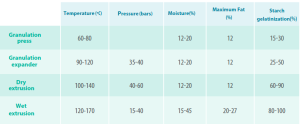
Thermal treatment of raw materials used in ruminant diets- Part 1
Thermal treatments, and their application in raw materials and feed concentrates optimizes their utilization, providing better nutritional and performance results in animals.
Main thermal treatments
We can divide heat treatments into 2 large groups:
- Dry: heated, dried and roasted.
-
Wet: heat and moisture (conditioning, cooking, granulation, expansion and extrusion). - Conditioning: Application of thermal treatments without producing changes to the physical format of the ingredient. It consists of heating the feed, generally through indirect heat. Its main objective is to sanitize, reduce or eliminate microorganisms, while facilitating a subsequent granulation process.
- Cooking and roller milling: Flakes are obtained through steam cooking at an approximate temperature of 100 ° C for periods between 40 and 60 minutes. These are then subjected to roller mills,where the drying takes place.
- Granulation: It is the most used process in feed mills. The trend in recent years is to shift towards a higher percentage of granulated and crumb feed in its different sizes. In this process, feed found in meal form, is transformed into granules (pellets) with different diameter and length. Achieving a final product with two fundamental properties: hardness and durability.
- Expansion: This process uses temperatures ranging from 90°C and 120°C and lower pressure values than extrusion. It is also used to treat, and expand individual or combined products such as: corn, soybeans, wheat, cakes, etc.
- Extrusion: It is considered as the most complex process and it employs the different variables with greater intensity. It is carried through the use of an extruder composed by one or two bodies. Raw materials are previously conditioned with the addition of liquids and steam before being subjected to the action of the extruder. The process occurs under conditions of high pressure and temperature values, ranging from 120°C and 170°C; exiting through a matrix where the highest pressure is applied.
Wet or humid thermal treatments can be performed through five different processes. The working conditions for these processes are shown in Table 1. 
Table 1. Working conditions of the different thermal treatment
